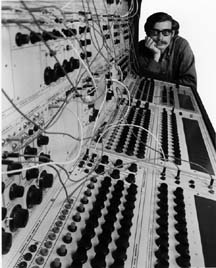◊ Historic Buchla Modules
Buchla pages > Buchla 100 modules
Buchla pages > Buchla 100 modules
Newly located early schematics added, Jan. 2023:
We are still looking for information on these modules:
Pages with descriptions are up, but still looking for pictures and schematics, let me know if you can help.
In 1963, Morton Subotnick and Ramon Sender put an ad in the San Francisco Chronicle, looking for an engineer to help build a new kind of electronic musical instrument. Don Buchla answered the ad, and about a year later delivered the first Buchla 100 series synthesizer to the San Francisco Tape Music Center. Here's how Don described the instrument:

The Modular Electronic Music System is composed of functional modules, each designed to generate a particular class of signals or perform a specific type of signal processing. Each module is 7 inches high and 4 1/4 inches (or an integral multiple thereof) wide. Up to 25 modules sharing a single power supply may be assembled in a single cabinet to form a super-module.
The system employs three varieties of signals, each with a distinctly different function:
The rules for interconnecting are straight-forward. Any number of inputs may be connected to a single output. Timing pulse outputs may be paralleled and connected to one input. The system output may be derived from any module; output is of sufficient magnitude to drive line inputs on tape recorders or sensitive inputs on power amplifiers.
In the past decade electronic music has developed
into a form that assumes all the roles of music in our culture, from concert
pieces to film music and rock-and-roll. Studios specializing in electronically
generated music have been built in Europe and America, and have exerted
considerable impact on the music field. Electronic music is now a part of
the curriculum of many college and university music departments and is now
used extensively for special effects in advertising commercials.
The offspring of a technology which is itself but half a century old, electronic
music is in its infancy. Instruments specifically designed for its production
have been crude and generally unavailable. Therefore, the basic objectives
for development of the Modular Electronic Music System were:
The Modular Electronic Music System meets the above criteria and has been installed in numerous colleges, composers' homes and studios throughout the country. Results have exceeded all expectations. The time required to put a composition on tape has been reduced substantially. The range of sounds and formats far exceeds that previously available.
NOTICE: The text, images, graphics, and other content of this website related to Don Buchla's legacy synthesizer designs is made available under the Fair Use Doctrine of the US Copyright Office. Fair Use limits the use of this information to personal, educational, and scholarly purposes (including right-to-repair, where applicable). It may not be used as the basis of commercial or for-profit works. Printed Circuit Boards may be purchased and assembled for your personal or educational use, but may not be manufactured and sold as "Buchla" products.